

CLFB_WomenLeadership. “Corporate Learning Is More Important Than Ever” An Interview with Josh Bersin. How to Make the Most of an Intern - Small Business Trends. Do you remember seeing the first buds on the trees in the spring?
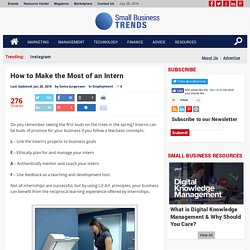
Interns can be buds of promise for your business if you follow a few basic concepts: L – Link the intern’s projects to business goals E – Ethically plan for and manage your intern A – Authentically mentor and coach your intern F – Use feedback as a teaching and development tool Not all internships are successful, but by using L.E.A.F. principles, your business can benefit from the reciprocal learning experience offered by internships. Before expanding on each of the L.E.A.F. concepts, let’s look at the benefits to your business of developing an internship program. First, your company gets to “sample” the talent. L: Link Projects to Business Goals Many businesses view an intern as free labor to do grunt work at will.
First, know what interns are looking for in an internship. How to Conduct a Lightning-Fast Needs Assessment Clients Will Love. I hear the same complaint from training and consulting professionals time and time again.

It comes in a variety of versions: “We want to conduct a needs assessment, but our clients don’t give us the time or resources.” “Clients just want us to train.” Then and Now - The Future of the Corporate University. Learning Delivery, Strategy A dual focus on business strategy and employee engagement can ensure a corporate university’s guiding principles align with those of the company.
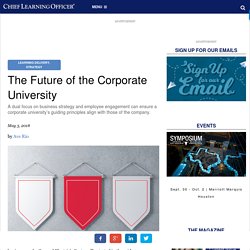
The first corporate universities were created more than 60 years ago as a place for employees to learn in conjunction with the company’s vision and business goals. What is informal learning. What is informal learning & how to promote it. Taking Competencies Out for a Spin. From the Magazine, Talent Management The fast pace of business today is causing some to question their approach to competencies.
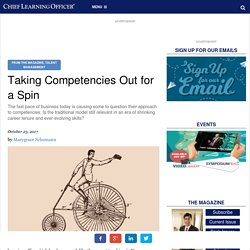
Is the traditional model still relevant in an era of shrinking career tenure and ever-evolving skills? Talent development has been much like learning to ride a bike and the chief learning officers’ job has been much like the parent teaching it. New employees get clear directions and support but at a certain point they’re expected to develop the necessary skills without someone pushing behind them. Competency models are like the hand on the back for many employees. In theory, this makes perfect sense but according to some it’s not the right approach for today’s workforce. Add to that the fact that skills needed for many jobs are changing at a rapid pace, making a traditional competency model obsolete faster than many companies can update it.
Inside Learning and Development at Mattel. Video Michael Nehoray describes the complexities of transforming learning and talent at the iconic toymaker.

Leadership is everyone’s role at Mattel says Michael Nehoray, vice president and head of global learning and organization development. The company is transforming its learning and talent functions through a declared set of aligned behaviors, capabilities and values that leaders model. Tags: behaviors, capabilities, change, Inside L&D, leadership, learning, Mattel, values. Designing Learning at the Speed of Business.
Artificial Intelligence Comes to Learning. Learning Delivery, Technology Amazon, Pandora and Netflix pioneered our technology-driven future, making personalized recommendations a reality for millions.
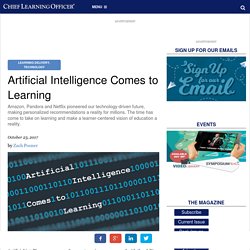
The time has come to take on learning and make a learner-centered vision of education a reality. Artificial intelligence, an area of computer science concerned with the ability of machines to simulate human intelligence, is swiftly remaking the world of work. From health care to industrial manufacturing, the ramifications are endless. In marketing, chatbots have already transformed customer experience. Within human resources functions, the applications are numerous. Degreed LENS 2017 – Curation Panel Discussion - St. Charles Consulting Group. Five Key Best Practices for Creating Your Learning Strategy. Creating your organization’s learning strategy is so much more than sitting in a room with your closest learning and development peers and writing a “learning manifesto” for the coming year.

Here are five key best practices to use when developing your annual learning strategy. 1. Know Your Business Know how your business operates, competes, and generates revenue. Make sure your strategy aligns with your organization’s critical business initiatives. Blog - St. Charles Consulting Group. Learning Curation. TL1 The Changing Nature of Work and Workers 2017 0929. TL2 Trends in Learning Within Organizations 2017 1102. The Evolution of the Learning Professional: From Developer to Curator. In the past, learning professionals were in the business of creating content to “train” people.

Learners experienced a lot more “telling” and “showing,” and often the communication between the instructor and the learners was one way, i.e., instructor to learner. An Agile Approach to Learning Strategy. Do your executives cringe when you mention learning strategy?
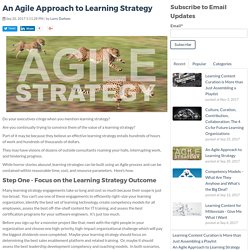
Are you continually trying to convince them of the value of a learning strategy? Part of it may be because they believe an effective learning strategy entails hundreds of hours of work and hundreds of thousands of dollars. Culture, Curation, Contribution, Collaboration: The 4 Cs for Future Learning Organizations. You Say "Evolution," I Say "Disruption" Thousands of articles have been written in the last few years about the changes that are happening to learning within organizations.
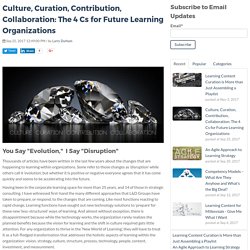
Some refer to those changes as ‘disruption’ while others call it ‘evolution’, but whether it is positive or negative everyone agrees that it has come quickly and seems to be accelerating into the future. Having been in the corporate learning space for more than 25 years, and 14 of those in strategic consulting, I have witnessed first-hand the many different approaches that L&D Groups have taken to prepare, or respond, to the changes that are coming.
Like most functions reacting to rapid change, Learning functions have sought out new technology solutions to ‘prepare’ for these new ‘less-structured’ ways of learning. Culture. Learning Content Curation is More than Just Assembling a Playlist. Many in the learning space have recently come to the realization that learning functions don’t need to try and command and control all learning content within their organization nor do they have the resources to create it all. Rather, they can become the curators of learning. Sounds intriguing, but, what does it mean when we say curation? Functions/organization/our-insights/learning-innovation-in-the-digital-age?ci... To make a transformation succeed, invest in capability building. Companies can vastly raise the odds of success if they take the time to build the needed capabilities.
Not all transformations or organizational-excellence programs succeed. But, on average, companies that implement effective capability-building programs as part of their transformations beat the odds: their transformations are 4.1 times as likely to succeed and derive 2.2 times the benefits from earnings before interest, taxes, depreciation, and amortization as those of other companies. Capability building is particularly critical in manufacturing transformations.
Learning Content Curation is More than Just Assembling a Playlist - St. Charles Consulting Group. Why leadership-development programs fail. Sidestepping four common mistakes can help companies develop stronger and more capable leaders, save time and money, and boost morale. For years, organizations have lavished time and money on improving the capabilities of managers and on nurturing new leaders. US companies alone spend almost $14 billion annually on leadership development. Colleges and universities offer hundreds of degree courses on leadership, and the cost of customized leadership-development offerings from a top business school can reach $150,000 a person. What’s missing in leadership development? Only a few actions matter, and they require the CEO’s attention. Organizations have always needed leaders who are good at recognizing emerging challenges and inspiring organizational responses. That need is intensifying today as leaders confront, among other things, digitization, the surging power of data as a competitive weapon, and the ability of artificial intelligence to automate the workplace and enhance business performance.
These technology-driven shifts create an imperative for most organizations to change, which in turn demands more and better leaders up and down the line. Unfortunately, there is overwhelming evidence that the plethora of services, books, articles, seminars, conferences, and TED-like talks purporting to have the answers—a global industry estimated to be worth more than $50 billion—are delivering disappointing results. Focus on the shifts that matter. 2012 building the key skills for the future. Google Spent Years Studying Effective Bosses. Now They Teach New Managers These 6 Things. The transition from individual contributor to manager is not an easy one.
In many cases, the skills that got you the promotion will not be the same ones that make you effective as a manager. Luckily, we have organizations like Google that have spent years researching this transition, to help us demystify the secrets to new managers' success. Using Project Oxygen, an internal study that analyzed more than 10,000 manager impressions including performance reviews, surveys, and nominations for top-manager awards and recognition, Google identified eight habits of highly effective managers.
Google also designed a management training workshop to share its newfound knowledge with its bosses and now the world. Tip #5/5 for Making Learning Stick: Unleash your learners! – Learn-o-rama. Learning Never Ends at McKinsey. Case Study, From the Magazine. Pizza Hut Takes Gamification to the Next Level. By Dee Dick Always interested in learning about best practices in talent development, I caught up with Amy Gingerich, Sr. Manager of Training and Development at Pizza Hut, to talk about their AXIS award-winning program, The Launch Pad. Complete Case Studies Guide. The 15 skills every L&D team needs. Building capabilities for performance. Learning at the speed of business.
What digital means for the next generation of corporate academies. Corporate universities are entering their second century, just as the businesses that rely on them are transforming themselves for the digital age. When pioneers such as General Motors and General Electric began offering standardized in-house training programs, about 100 years ago, they focused on imparting lower-level, day-to-day skills. How to scale personalized learning. A systemwide approach offers the best chance of reaching the most students. 7 Tips To Keep Learner Focus In The Modern Learners’ World - eLearning Industry. As eLearning becomes more prevalent in the work place, and mobile learning on smartphones is a common strategy, training activity comes up against the reality of the modern learner; it’s hard to keep learner focus.
Infographic: Why Employees Resist Change - Catherine's Career CornerCatherine's Career Corner. Save By Catherine Adenle. How companies manage the front line today: McKinsey Survey results. Most companies don’t offer sufficient training for frontline managers or structure their roles to create the most value. Aggravating the problem, senior leaders are often unaware of the issues that hinder frontline performance. Unlocking the potential of frontline managers. Instead of administrative work and meetings, they should focus on coaching their employees and on constantly improving quality. A retail manager responsible for more than $80 million in annual revenue, an airline manager who oversees a yearly passenger volume worth more than $160 million, a banking manager who deals with upward of seven million questions from customers a year.
Putting a value on training. Why leadership-development programs fail. 10 Trends for Workplace Learning (from the Top 100 Tools for Learning 2015) 4 Steps to Create A Learning Path. Use Learning Paths to develop the right Learning Strategy. Developing a Structured Learning Path. Defining Adaptive Learning Paths For Competence Or. Attitudes towards training from two perspectives. Now is the Time for Workplace Learning to Focus on Individual Learnability. It’s not about training: thinking strategically about talent development.
6 Reasons Well-Intentioned Leadership Training Backfires. How to Be an Amazing Mentor: 12 Ways to Make a Positive Impact on Others. 6 Reasons Well-Intentioned Leadership Training Backfires. There’s an Alternative to Leadership Development. Top 10 new teaching techniques for 2015. Docebo thenew 702010 whitepaper. Aberdeen Employee Knowledge Report March 2016. The What and Why of Experiential Learning. Infographic: Why Corporate Training is a Colossal Waste (and What to Do About It) The Evaluation of Training - From Happy Sheets Up to ROI_0.